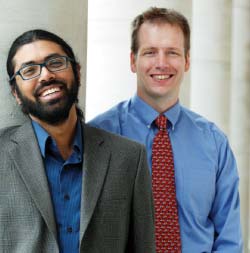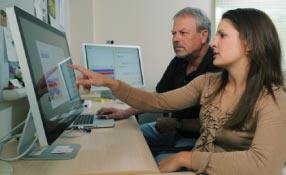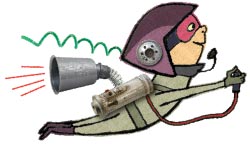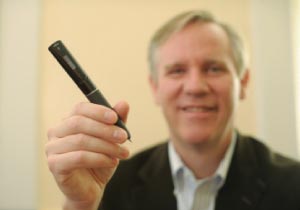 What if a fifth grader could learn college-level physics concepts? What if the platform used to teach those concepts could be accessed very simply online through a Web browser? What if that new methodology allowed students to write computer programs, progress at their own pace and provide the teacher immediate feedback on individual progress?
What if a fifth grader could learn college-level physics concepts? What if the platform used to teach those concepts could be accessed very simply online through a Web browser? What if that new methodology allowed students to write computer programs, progress at their own pace and provide the teacher immediate feedback on individual progress?
As it turns out, these questions are not just “what ifs” thanks to several groundbreaking education technology platforms under development in labs across the Peabody campus. These innovations allow cutting-edge researchers to harness what Pratim Sengupta, innovator of the technology described, calls “the virtue in virtuality.”
Common among these developing platforms is their commitment to accessibility, focus on efficiency and effectiveness, and an emphasis on STEM (science, technology, engineering and math) topics. A driving theme is a desire to free teachers up for more instructional time and, ultimately, improve learning outcomes.
Technological innovations always begin with a passion to tackle intransigent problems. Once a problem in need of a solution is identified, “then we ask, ‘To what extent could the use of technology make this more accessible to learners?’ The technology comes in on the back end,” says Andy Van Schaack, assistant professor of the practice of human and organizational development.
Many steps follow prior to implementation—from designing technology to data generation to extensive testing. The ultimate question is always how well the technology works.
“There are a lot of teaching technologies that are worse than nothing,” Van Schaack says. Of utmost import is which strategies provide an edge in the classroom. “I believe that the most effective instructional technologies are the ones that require the fewest changes in behavior on the part of the teachers and the learners,” he says.
A focus on science and math
In the design and testing stage is Sengupta’s Visual Multi-Agent Programming (ViMAP) platform. The idea behind ViMAP is to encourage students to use their intuitive knowledge rather than memorization to grasp complex science concepts through building computer programs that can model real-world phenomena.

If scientists and mathematicians want to inspire a new generation of students to push the limits of human understanding, then that thrust has to begin in elementary school, according to Sengupta, assistant professor of teaching and learning. His driving passion is his belief that young children can learn difficult concepts.
“Here’s an interesting evolutionary question,” Sengupta says, “What if my fifth graders can learn stuff they are supposed to learn in college? What will the learning progression look like when these students move to advanced grades? These are the questions I want to answer, and I think that’s going to be my life’s work.”

A basic tenet for Sengupta, who also collaborates with Gautam Biswas, professor of computer science and computer engineering, is to begin with simple concepts such as movement and speed before progressing into the more difficult ones rather than teaching formulas right off the bat. “Why are we teaching them formulas when they should be building models, just like real scientists?” Sengupta asks.
Learning with ViMAP takes place on the screen without the need for expensive lab equipment or space. Through using ViMAP, students can also develop computational thinking, a hallmark of modern scientific expertise in almost any domain of science.
ViMAP consists of several modules currently under development in different disciplines, including physics (with a focus on mechanics and electricity), ecology and mathematics. With ViMAP-Mechanics, for example, students begin by exploring the concept of speed.
I believe that the most effective instructional technologies are the ones that require the fewest changes in behavior on the part of the teachers and the learners.
—Andy Van Shaack
“We have created a programming toolkit that will allow them to move from a qualitative understanding to a more formal understanding of the equation of motion,” he says. “We are not discarding but leveraging their intuition.”
These new tools allow students to immediately practice the concepts they are learning in the classroom.
One way to increase practice time is to make it a game. Consider that the online computer game “World of Warcraft” attracts 12 million gamers, while only a tiny portion of that number enter STEM disciplines each year, says Doug Clark, associate professor of science education, who works with Sengupta on several grant projects.
Creating a mechanism to channel the teen-age obsession with gaming into an avenue for teaching scientific concepts is behind his work. Results from a fun but educational game he’s developed to teach core physics concepts are extremely encouraging. The game, “Surge,” is funded through a $450,000 National Science Foundation grant.
“Games are becoming a real possible avenue for learning, either in school or out of school,” Clark says. “Kids spend as much time out of school playing games and watching TV as they spend in school. If you can get anything out of those hours, it’s a huge windfall. We’ve helped kids make more progress on some measures in one-and-a-half hours than in a whole semester of college,” he says.
According to Clark, games are ripe for guiding students toward an intuitive understanding of basic physics concepts since many of them are about maneuvering through space, but games rarely allow for learning opportunities.

“What we’re trying to do is connect intuitive ideas to formal ideas so that they can actually learn something,” he says.
The ultimate goal is to help develop a core of students excited about STEM disciplines. “Every kid in the United States needs to learn about force and motion and Newton’s laws. But the way it’s done traditionally, kids just don’t get it,” Clark says. “Schools and traditional teaching tend to focus on abstract but very powerful ideas that are disconnected from students’ experiences.”
Certainly, games are not going to replace teachers, but Clark believes games can augment and reinforce what is happening in the classroom.
The efficiency experts
Saving time in the classroom so that teachers can focus more on instruction is one of the fundamental concepts of a math instruction program under development by Maria Mendiburo, research associate in electrical engineering and computer science, and Ted Hasselbring, research professor of special education. They have found a way to help teachers build deeper understanding in their students with a program using virtual manipulatives to learn fractions.

As a Peabody graduate student, Mendiburo watched a presentation about Hasselbring’s groundbreaking Read 180 program and was inspired to apply the idea to math education and, more specifically, to learning fractions.
“Time’s a huge issue in schools,” says Hasselbring. “We need to maximize the time that kids are engaged in academic pursuits. We found that this methodology actually increased instructional time and the amount of time kids have to respond to the instruction.”
When teaching fractions by using physical manipulatives, there is a significant cost to purchasing the materials for multiple students, and it’s a hassle to store the material between lessons. Further, instructional time is often lost in distributing and collecting manipulatives, not to mention the problems that arise when pieces are lost or misplaced.
The first step, which was part of Mendiburo’s dissertation for her Ph.D. in leadership and policy studies at Peabody, was to find out whether virtual manipulatives actually work. She found a slight edge in the learning process using the virtuals over paper and, more important, greater efficiency.
When grading papers, I find that many students make the same mistakes. I can speed up grading considerably by copying and pasting 30-second spoken tutorials from a master list into their papers.
—Andy Van Schaack
Through a three-year, $1.5 million development and innovation grant from the Department of Education’s Institute of Education Sciences, Mendiburo and Hasselbring are working with Biswas and others to develop a program that is compatible with computers as well as the new iPad. The advantage of iPads is that children can approach them intuitively, using touch rather than clicking and dragging using a mouse, Hasselbring says. It allows virtual manipulatives to emulate physical manipulatives much more closely.
While many computer tutorials are individualized, this one is designed for whole class instruction, although it does allow students to progress at their own pace. It has added value for children who are struggling with learning, a career-long focus for Hasselbring.
The students are monitored and rewarded while immediate feedback on progress is provided to the teacher, allowing the teacher to spend less time on grading and more time on instructing students in areas of difficulty for them.
Learning fractions and many other concepts requires practice. A basic problem to be solved in a classroom is how to provide more practice time for students with feedback from the teacher—since practice is still one of the best ways to learn—without exponentially increasing the workload for the teacher or the cost to the school, Van Schaack says.
He is taking the challenge of finding ways to help teachers provide more and better feedback to their students in multiple subject areas by grading papers faster and more effectively through the use of smart pen technology.
Van Schaack is one of the inventors of a smart pen produced by Livescribe. The pen, called “Echo,” is a computer with built-in microphone, speaker and display. The pen captures everything a user hears or says and synchronizes it with what they write. A student just taps on a word or drawing in a notebook to play back the audio recorded at that moment.

Grading papers is always a huge time management issue for teachers. The smart pen technology could help teachers to provide spoken feedback in tandem with written feedback. This technology has potential applications for grading everything from calculus homework to essays to sheets of music. “When grading papers, I find that many students make the same mistakes. I can speed up grading considerably by copying and pasting 30-second spoken tutorials from a master list into their papers,” Van Schaack says.
Studies conducted by other researchers have found that teachers were able to provide two-and-a-half times more feedback in spoken form than in writing— in one quarter of the time. Students also felt more connected to their teachers.
Van Schaack fervently advocates mining existing research rather than reinventing the wheel at every step. “I’m a pragmatist,” Van Schaack says. “I want to have impact now.”
He tackles problems not just from the education angle but from a scientific and business side as well. He spent time working with Apple in higher education sales and found he couldn’t convincingly sell a product until he was certain that he understood its benefits. That led to an interest in research about technology and in developing new technologies that work to provide real solutions.
The smart pen technology also has the potential to help students who are blind study math and science—subjects that make significant use of equations, diagrams and other visual representations. The pen would be used to create raised line drawings annotated with audio recordings, called “audio-tactile graphics,” that could be accessed by tapping on them. That work is progressing through a $300,000 grant from the National Science Foundation.
From the lab to the classroom
There are multiple ways to bring education technology with an edge to the marketplace, and each of the researchers emphasize that no single way is necessarily the best.
Van Schaack was involved in forming a company, Livescribe, to sell and market the smart pen. He is senior science advisor, and Livescribe has a CEO and a team of business experts to manage the business side.
In the case of Sengupta and Clark, their plan is to make the technology available for free through a browser.
Hasselbring and Mendiburo hope to attract a publisher once their project is complete. A publisher has the business-side expertise to manage issues such as marketing and distribution, Hasselbring says.
Another avenue is seeking out investors. Frank Bonsal, MEd’93, MBA‘04, is a venture capitalist who searches out promising, emerging technologies for investment, reviewing “dozens and dozens” of opportunities annually. He sees a potential trend in bringing technologies to market that will provide instructional innovation for STEM disciplines, especially when combining one or more of those topics.
“It’s a newer trend and there aren’t that many people involved in it yet,” he says. No Child Left Behind, he predicts, also will continue to drive solutions.

Bonsal spent nearly 15 years teaching and coaching in middle school and high school before joining Bonsal Capital, the venture capital firm founded by his father, Frank Bonsal Jr.
He eventually left the family firm to become a partner in New Market Venture Partners, specializing in information technology, education and healthcare. He also serves on the board of Questar Assessment Inc., which focuses on large-scale K-12 assessment, both from business services and online perspectives and is board observer at Moodlerooms, Inc and Starfish Retention Solutions Inc.
Education technology is still an emerging platform for most investors. Postsecondary platforms currently are the bigger success stories, but Bonsal predicts a brighter future for K-12 technologies in the next decade.
The most successful technologies are the ones that help teachers individualize learning, he says. “I taught in Charlottesville [Va.]. I had kids from a wide spectrum of ability, and I was supposed to teach all of those ranges. It’s pretty hard. You can really add value if you can create a Web medium and allow the user to personalize and individualize the speed with which students learn.”
Hasselbring, who has spent much of his career in education technology innovation, agrees that new instructional technologies must be effective at promoting advances in both teaching and learning.
“My biggest criticism is that a lot of developers of education technology have not paid attention to what we know about human learning,” he says. “What’s different about what we’re doing now is that we focus first on how humans learn. We know technologies can be helpful, but teachers don’t always use them. We’re trying to leverage our understandings and make [technologies] better and more efficient. If we do that, we’re going to have a much better outcome.”